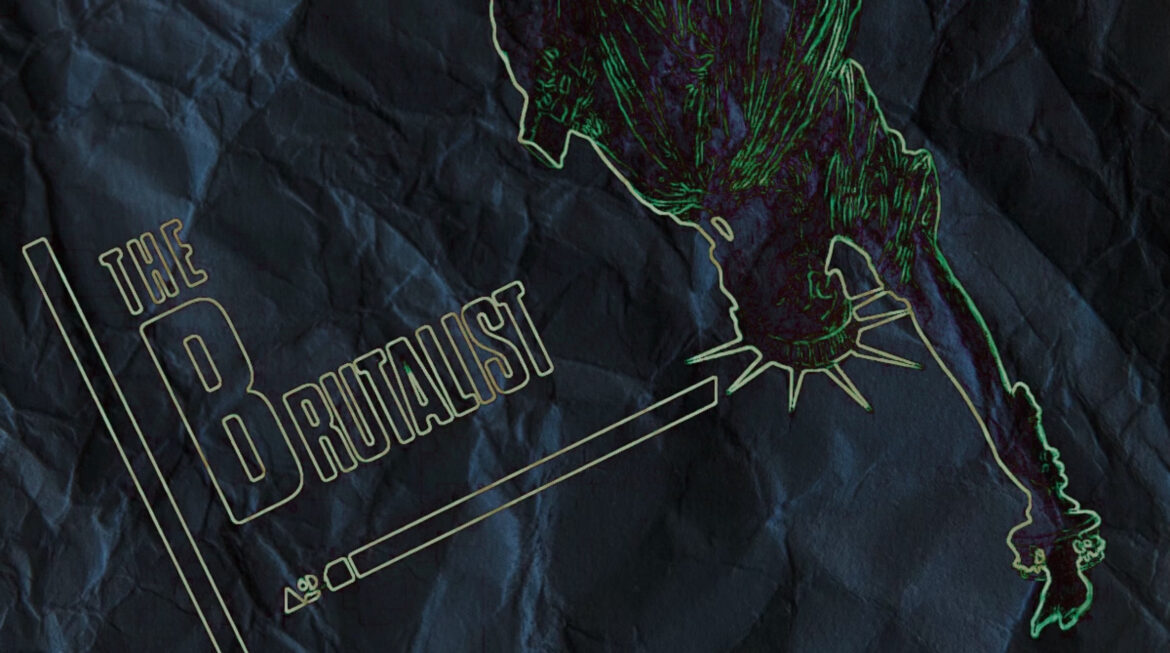Graphic by Ali Jacksi
“Nothing is of its own explanation. Is there a better description of a cube than that of its construction?”
Laszlo Toth, the protagonist of Brady Corbet’s 2024 film The Brutalist, asks this essential question at a glamorous dinner party where he is decidedly out of place. For Toth, an accomplished yet tortured architect with a grand vision for how he can shape the world around him, the end result is the only thing that matters; the only justification needed. Corbet offers audiences a film equally unapologetic in its conception. For some, watching the movie may feel like an arduous undertaking, but it triumphs as a film brimming with perceptive ideas and impressive craftsmanship upon completion.
The Brutalist is refreshing in its originality. Unlike all the spinoffs, sequels and superhero movies that thrive at the box office, or the stylish comedies and horror films that have come to dominate pop culture, Corbet’s film unabashedly embraces its artistic indulgences. Every moment presented on screen attempts to tell the audience something, sometimes through deeply uncomfortable and intimate means. At times, it can feel excessive and over the top, but it never compromises. Through this unrepentant direction, Corbet manages to provide audiences with undiluted artistry, rife with audacious and aspirant storytelling and masterful filmmaking strokes.
The film chronicles the life of Toth, played by an evocative and striking Adrien Brody, after he flees the horrors of a war-torn Europe in the aftermath of World War II. As he arrives in the United States, the Jewish-Hungarian immigrant is quickly swallowed up by the all-consuming futility of the American dream, only to escape his stateside anonymity when he encounters wealthy businessman Harrison Van Buren, depicted by Guy Pearce, in a deft performance that swirls with notes of menace and insecurity. Van Buren tasks Toth with a massive architectural endeavor, and from there, the two men engage in a timelessly complicated artist-benefactor relationship.
Despite critical acclaim — including an Oscar win — The Brutalist was received meagerly by general audiences. The film earned just over $15 million at domestic box offices, an underwhelming number considering the independent production cost $10 million.
Exactly why the film has fallen short of breaking into the mainstream likely has to do with how it was made. Corbet created a film that feels like it came out of a time capsule. Shot almost entirely on VistaVision, a widescreen format last used in Hollywood in the 1960s, The Brutalist has a granular, antiquated aesthetic. It also runs a staggering three-and-a-half hours, including a 15-minute intermission — a runtime just short of Lawrence of Arabia. Besides these technical aspects, its subject matter is somehow both painfully intimate and exceedingly vast, something more akin to The Godfather than to Wolverine & Deadpool.
These aren’t convincing selling points to entice the modern-day movie-goer, as evidenced by the highest-grossing films in 2024. Every movie that finished in the top 10, from Inside Out 2 to Sonic the Hedgehog 3, is either a sequel, spinoff or retread of familiar intellectual property. It seems a growing number of audiences want to know what’s in store for them before they even step into the theater.
But it’s precisely because Corbet makes his movie exactly the way he wants, to his unique idiosyncratic inclinations, that the film flourishes. Every decision seems to be deliberate. The decision to film with older equipment creates an ambiance transcending time, steadily blurring the lines between what once was and now is. Despite the extended length of the movie, it never really drags; each moment is meticulously crafted and brimming with complex ideas, although the intermission is a welcome break to stretch your legs. And while the story does not entertain in the way, let’s say, a Marvel movie might, or even another indie film like Best Picture winner Anora, it serves a greater purpose — it provides a thought-provoking, intellectually rigorous cinematic experience that feels increasingly rare nowadays.
The film anchors itself to the architectural style of brutalism, a minimalist approach that prioritizes functionality over decoration. The style was first popularized in Europe in the 1950s during postwar reconstruction. It often produces blocky, monochromatic concrete buildings adorned with harsh edges and peculiar angles. Brutalism is a divisive aesthetic; some find beauty in its raw and unconventional nature, while others are put off by its domineering austerity. This polarizing aspect makes it the ideal vessel for Corbet’s complicated yet ultimately rewarding story.
Like brutalist architecture, The Brutalist is raw and blunt. Yet, the film overflows with vast thematic purpose: it’s an exploration of identity, of reconciling one’s own self in the context of the American experience, specifically for immigrants; it’s trying to figure out how art is meant to survive in an increasingly commercialized world.
By examining the toils of Toth and the relentless commitment the character demonstrates, Corbet forces the audience to confront the enduring legacy of art in the face of unseemly exploitation. Toth’s attempt to execute Van Buren’s grand and impetuous dream in the vein of his own artistic integrity sets up a mighty clash of ideals: it exposes the fraught balance of navigating individuality amidst the consuming nature of assimilation. This conflict also underscores the tragedy inherent to Toth’s character. All at once, he must internalize the debilitating traumas he has suffered while pushing toward a new, almost inconceivable future.
The film nearly falters because it almost feels too broad in its scope. In every other scene, it seems Corbet is trying to unpack several highly complicated and nuanced ideas. What saves it from being a drawn-out mess of indulgent patterings, like Francis Ford Coppola’s poorly-received Megalopolis – although it’s always appreciated when a legendary filmmaker takes a big swing – is the uncompromising vision Corbet cultivated with the film’s distinct stylistic underpinnings. Its award-winning cinematography, helmed by Lol Crawley, beautifully captures the grandeur of artistic enterprise simultaneously at odds with the agonizing intimacy of the characters. Opening shots of a shaky, upside-down, then flipped sideways Statue of Liberty, as a haggard yet hopeful Toth enters America, set the tone early of a film unafraid of its prescience.
The movie’s score is also instrumental in grounding the story. Orchestrated by Daniel Blumberg — the former frontman of the band Yuck, whose hit song “Get Away” is a jam — the musical composition of the film lends itself entirely to the story being told. Combining melodic piano lines with a sweeping, incongruous orchestra, Blumberg evokes the epic scale at hand by casting the story in sounds of emphatic ambition jumbled with mesmeric hints of imperiling doom. Corbet’s devotion to scrupulously shaping the film in its entirety pays dividends. Every component is carefully considered and fosters an atmosphere compatible with a script that’s saturated with innumerable intentions.
It’s quite fitting that The Brutalist has been acclaimed for its artistic ingenuity, as it demonstrably celebrates precisely that. Ironically, although the film lambasts the oppressive cultural controls pervading the art world, it has been mired in controversy for its use of artificial intelligence. Corbet’s team used generative artificial intelligence to enhance the accents of Brody and Felicity Jones, who plays Toth’s wife, in the few scenes where they speak in Hungarian. Corbet says there was no alteration in their performances for the parts where the characters speak in English, which is most of the movie.
While it’s forgivable to touch up an accent to add a layer of authenticity to a performance, it sets a complicated precedent for when and how artists should use these technologies. On shoestring budgets, independent filmmakers are focused on crafting the best, most genuine films they can conceive as quickly and cheaply as possible. However, by using AI, Corbet opened up a broader conversation about the acceptable convergence of art and generative technologies that circumvent human origination. The use of AI was a sticking point for Hollywood actors and screenwriters when they went on strike only a couple of years ago. Most people don’t want to lose their jobs to a machine or have algorithms replace human creativity.
However, an evident problem with a zero-tolerance approach to technologies like AI in creative spaces is that it may ultimately limit the breadth of the art-making process. The utilization of this type of technology in filmmaking seems inevitable. Rather than wholly denying its use in film studios, the industry should take care to safeguard the artistic process while allowing AI to assist in areas that are generally more expensive and time-consuming. This will help to democratize the film industry, enabling independent production companies to pursue more ambitious projects that otherwise would not be feasible, toppling big-budget studios’ monopolistic hold on large-scale productions.
The begrudging acceptance of groundbreaking technologies in film isn’t new. On the set of Jurassic Park, Steven Spielberg famously had a computer-generated imagery (CGI) team compete against a practical effects team to create the best T-Rex design. After seeing the results, the head of the practical effects team reportedly said, “I think I’m extinct.”
That clearly wasn’t the case, as practical effects are still widespread and instill an irreplaceable air of reality in any movie. Still, it’s obvious that CGI has played an essential role in reshaping how stories are told through film. Although one could easily argue that CGI has become too prevalent in modern cinema, it’s undeniable that it has pushed movie-making forward, expanding what filmmakers can manufacture from their imaginations. Similarly, AI can coexist with contemporary movie-making practices as long as it doesn’t start replacing the innate human ingenuity that makes art indispensable.
The AI post-production alteration to Brody’s voice caused many to suggest he was undeserving of the Best Actor award, which he won. However, his performance was far more than a few lines of perfectly spoken Hungarian. Playing the beleaguered Toth, Brody is enigmatic in the best way possible. He’s hypnotic and emotive, effortlessly carrying the complexity of a character entrenched in a toxic American dreamscape. Brody eloquently displays both the triumphant highs of successful endeavor and the tumultuous lows of spiritual defeat. A minor editorial change to Brody’s Hungarian accent does not diminish the luster of his consummate performance.
Towards the film’s end, a character says, “No matter what the others try and sell you, it is the destination, not the journey.” The story of The Brutalist is, in fact, a decades-spanning journey filled with miserable yearning and captivating aspiration. But, the ultimate reward for both Toth and the audience is the redemptive nature of an enduring legacy — a destination that supersedes the finite struggle of getting there in the first place.



Comments are closed.